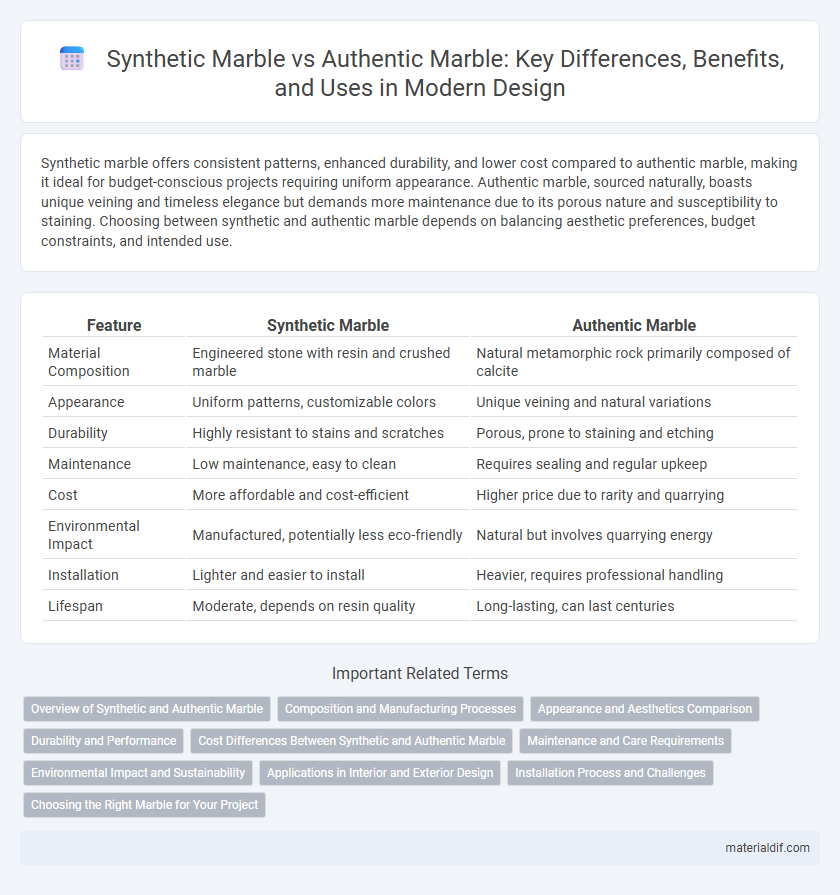Synthetic marble offers consistent patterns, enhanced durability, and lower cost compared to authentic marble, making it ideal for budget-conscious projects requiring uniform appearance. Authentic marble, sourced naturally, boasts unique veining and timeless elegance but demands more maintenance due to its porous nature and susceptibility to staining. Choosing between synthetic and authentic marble depends on balancing aesthetic preferences, budget constraints, and intended use.
Table of Comparison
| Feature | Synthetic Marble | Authentic Marble |
|---|---|---|
| Material Composition | Engineered stone with resin and crushed marble | Natural metamorphic rock primarily composed of calcite |
| Appearance | Uniform patterns, customizable colors | Unique veining and natural variations |
| Durability | Highly resistant to stains and scratches | Porous, prone to staining and etching |
| Maintenance | Low maintenance, easy to clean | Requires sealing and regular upkeep |
| Cost | More affordable and cost-efficient | Higher price due to rarity and quarrying |
| Environmental Impact | Manufactured, potentially less eco-friendly | Natural but involves quarrying energy |
| Installation | Lighter and easier to install | Heavier, requires professional handling |
| Lifespan | Moderate, depends on resin quality | Long-lasting, can last centuries |
Overview of Synthetic and Authentic Marble
Synthetic marble, made from resin and crushed stone, offers consistent patterns, durability, and lower cost compared to authentic marble, which is a natural metamorphic rock formed over millions of years with unique veining and color variations. Authentic marble's porous surface requires regular sealing to prevent stains, whereas synthetic marble provides better resistance to moisture and chemicals. Both materials serve distinct applications in architecture and interior design, with synthetic marble preferred for its uniformity and maintenance ease, while authentic marble is valued for its natural beauty and prestige.
Composition and Manufacturing Processes
Synthetic marble, primarily composed of polyester resin mixed with marble dust and pigments, undergoes a casting or molding process that allows precise control over color and pattern consistency. Authentic marble is a natural metamorphic rock formed through intense heat and pressure on limestone, resulting in unique veining patterns and mineral composition exclusive to each quarry. Manufacturing synthetic marble involves curing and polishing to achieve a smooth, durable surface, whereas authentic marble requires quarrying, cutting, and finishing to reveal its natural beauty.
Appearance and Aesthetics Comparison
Synthetic marble offers consistent color and pattern uniformity due to its manufactured process, providing a sleek, modern look ideal for contemporary designs. Authentic marble exhibits unique veining and natural variations, imparting a luxurious and timeless aesthetic favored in classical and high-end applications. While synthetic marble mimics the appearance of natural stone, authentic marble's depth and texture remain unmatched in creating a refined visual impact.
Durability and Performance
Synthetic marble offers enhanced durability due to its resistance to stains, scratches, and impact compared to authentic marble, which is more porous and prone to chipping and etching. Performance-wise, synthetic marble maintains a consistent appearance with low maintenance requirements, while authentic marble requires sealing and careful upkeep to preserve its natural beauty. The engineered composition of synthetic marble allows for greater flexibility in design and improved long-term wear in high-traffic or moisture-prone areas.
Cost Differences Between Synthetic and Authentic Marble
Synthetic marble typically costs 30% to 50% less than authentic marble due to lower material and manufacturing expenses. Authentic marble involves quarrying, transportation, and labor-intensive cutting, driving up its overall price significantly. Budget-conscious projects often favor synthetic marble for its cost-effectiveness without compromising aesthetics.
Maintenance and Care Requirements
Synthetic marble requires less maintenance than authentic marble, as it is non-porous and resistant to staining, scratching, and moisture damage. Authentic marble demands regular sealing and careful cleaning to prevent etching, staining, and surface wear due to its porous nature. Synthetic marble's durability and low upkeep make it suitable for high-traffic areas, while authentic marble needs vigilant care to preserve its natural beauty over time.
Environmental Impact and Sustainability
Synthetic marble is manufactured using resins, polymers, and crushed stone, leading to lower quarrying impacts and reduced natural resource depletion compared to authentic marble, which requires extensive mining and generates significant landscape disruption and carbon emissions. The production of synthetic marble often utilizes recycled materials and consumes less water, promoting greater sustainability, while authentic marble extraction results in habitat destruction and large amounts of waste byproducts. Life cycle assessments consistently show synthetic marble as a more environmentally responsible alternative due to its minimized ecological footprint and enhanced potential for circular use.
Applications in Interior and Exterior Design
Synthetic marble offers greater versatility in exterior design due to its enhanced durability, weather resistance, and low maintenance requirements, making it ideal for cladding, facades, and outdoor sculptures. Authentic marble remains preferred in interior design for luxury applications like countertops, flooring, and decorative wall panels owing to its natural veining, unique patterns, and classic aesthetic appeal. Both materials are selected based on project requirements, with synthetic marble providing cost-effective, customizable solutions while authentic marble delivers timeless elegance and organic beauty.
Installation Process and Challenges
Synthetic marble offers a more straightforward installation process compared to authentic marble due to its lightweight nature and uniform sizing, reducing labor time and complexity. Authentic marble requires skilled craftsmanship for cutting, fitting, and sealing because of its natural variations, increasing the risk of cracks and installation errors. Challenges with authentic marble also include longer curing times and the need for specialized tools, while synthetic marble provides quicker, more consistent results with less potential for damage during installation.
Choosing the Right Marble for Your Project
Synthetic marble offers enhanced durability, uniform appearance, and cost-effectiveness compared to authentic marble, making it suitable for high-traffic areas and budget-conscious projects. Authentic marble, prized for its natural veining and unique patterns, provides timeless elegance and increases property value but requires regular maintenance due to its porosity. Selecting the right marble depends on balancing aesthetic preferences, maintenance willingness, and project budget to ensure long-lasting satisfaction.
Synthetic Marble vs Authentic Marble Infographic

 materialdif.com
materialdif.com